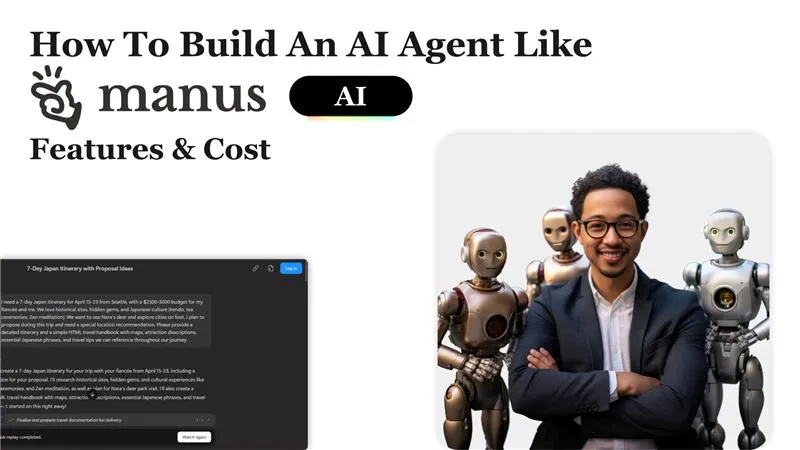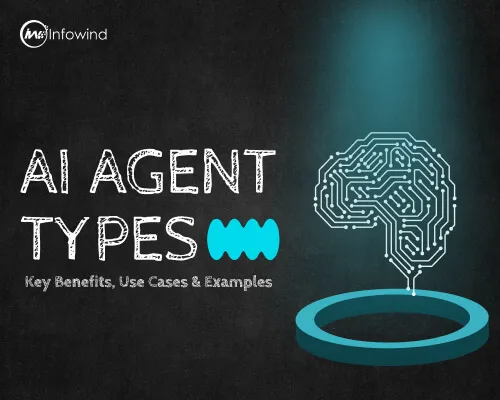Modern business innovation functions as an engine driven by Artificial Intelligence which is beyond its buzzword status. The operational framework of companies is changing drastically as autonomous customer service and intelligent data analysis performed by AI agents increase in speed. Manus AI represents a new wave of artificial intelligence systems that receive rising recognition because of its capabilities to think in real-time and operate autonomously with natural language processing features.
Research by McKinsey indicates that more than half of all organizations have integrated AI into one or several business operations, while AI-driven productivity will generate $4.4 trillion annually for worldwide economics. Because of this accelerating momentum, companies view building powerful AI agents like Manus AI as more appealing than ever; however, they need to know how to create such systems.
This comprehensive guide explains the technical elements and core features, development timeline, and practical worth of an AI agent such as Manus AI. This blog serves startup founders, software developers, business leaders, or anyone interested in AI because it explains details about intelligent agent construction beyond the surface level.
Our investigation begins with how next-gen AI functions for the creation of Manus AI. We will now examine all aspects needed to create this breakthrough AI technology like Manus AI.
Understanding Manus AI: What Does It Do?
The rising technology Manus AI functions as an autonomous AI agent that handles sophisticated job assignments utilizing normal verbal instructions. The decision-making features together with contextual understanding capabilities and self-learning abilities provide Manus AI with strength as an automation tool for businesses pursuing scalable operations through intelligent automation systems.
Manus AI incorporates GPT technology as an AI assistance system that integrates with automation code bases and customizable choice engines. The system dynamically processes context while taking actions and develops its understanding through continued operation. The system operates for complex task execution instead of basic user interface usage.
Real-World Use Cases
- Business Process Automation facilitates the automatization of workflows which includes onboarding processes, scheduling tasks, and reporting duties with data entry functions.
- The virtual operations manager function of Manus AI enables it to manage emails, produce documents, and perform database analysis tasks.
- Through its research capabilities, Manus AI extracts web data from sources and then transforms them into summaries and valuable insights to serve as an advanced AI research platform.
- Company Relationship Management Systems (CRMs) allow this platform to provide intelligent support during user inquiries and lead management.
What Sets It Apart?
The AI system Manus AI functions task-focused while being self-operating and runs with modern large language models of which OpenAI’s GPT-4 represents one such model. The system utilizes large language model cognition to operate with practical tools which include APIs, databases, and scripts for performing holistic multi-step operations. Manus AI stands as an advanced next-gen artificial intelligence agent because it joins natural language processing methods together with automatic task execution functions.
The business sector selects Manus AI because it delivers real-world usage along with expandable features that integrate deeply into operations instead of acting like standard chatbots.
Core Features of an AI Agent Like Manus
The development of artificial intelligence agents at an advanced level through Manus requires components beyond a barebones conversational interface. Modern systems have to duplicate human decision patterns while allowing connection to real-world executing tools for intelligent automatic job completion. Agents like Manus AI run through these primary features for their operation:
a. Autonomous Decision Making
The main attribute of contemporary AI agents function through an operational state requiring minimum human oversight. With both reasoning engines and intelligent planning modules Manus autonomously divides objectives into executable steps while selecting the most effective procedure to achieve the goals. After accepting a directive such as “create a competitor analysis” Manus automatically obtains the necessary data and constructs the report before delivering the final product.
b. Natural Language Understanding (NLU)
The core system of Manus AI functions through advanced natural language processing (NLP) equipped with GPT-4 and similar large language models (LLMs). These AI models enable the system to receive user input and identify its purposes before generating eloquent and meaningful responses. The AI creates a direct and easy-to-use experience that technical expertise does not demand from the user.
c. Integration Capabilities
Manus operates outside its isolated system because of its dependence on API-based connections. The platform links up with CRMs, project management tools, Notion, Slack, databases, and an unlimited number of SaaS platforms through its integration capabilities. AI integration within this system lets it process information alongside workflow automation to function as a unified operational center for business operations.
Also read: Web Services vs API vs Microservices
d. Contextual Memory and Learning
The main distinguishing feature is its ability to remember environmental context. Through its capacity to remember past experiences, outcomes, and preferences Manus delivers increasingly personal and appropriate responses to users in the course of time. A long-term memory system plays an essential role in achieving human-like consistent exchanges between systems.
e. Multi-Agent Collaboration (Optional)
Multiple AI agents running on Manus can synchronize their operations by assigning distinct sections of complex tasks to jointly deliver unified solutions.
f. Task Management & Automation
Manus AI provides a strong task management system that administers scheduling along with status tracking, retries, and reporting functions. The system provides complete reliability and transparency throughout automated workflows to establish itself as a digital workforce.
The Technical Architecture Behind Manus-like AI Agents
Manus AI requires a smart system architecture that seamlessly integrates conversational modules with robust back-end functionality. A comprehensive examination of the main elements required for an AI agent framework exists within this high-level description.
Frontend (Interface Layer)
Interfaces accessible to users consist of chat-based user interfaces that combine with web dashboards, mobile applications, and voice command systems. Real-time interfaces on desktop and mobile platforms allow users to connect directly with the AI agent because of this defining layer in the architecture.
Backend (Agent Core)
The core of the AI system consists of Large Language Models which include GPT-4 alongside Claude and operates with LLaMA and Mistral as open-source choices. The agent benefits from these models to reason and perform understanding and generation tasks.
A workflow engine including LangChain, AutoGen, and AgentOps allows the AI to execute sequences of tasks by planning autonomous execution of multi-step operations. The state management tools alongside memory systems help the agent both keep track of context flow and sustain active sessions as well as remember past user activities for sustained customer relationships.
Integration Layer
Through this layer, the agent establishes its external connections. The integration layer of Manus AI operates through API connectors, webhooks along with RPA tools to link with CRM systems and cloud services as well as internal databases and productivity applications. By connecting with real-time data access features the platform achieves its status as a connected AI agent with cross-platform task execution capability.
Data Storage
Manus uses Pinecone or Weaviate vector databases alongside SQL/NoSQL databases for semantic memory functions and retrieval of traditional data structures.
Security Framework
User authentication together with permission control and encryption of data during rest and transmission should be present in a secure AI system. The solution complies with enterprise standards and safeguards all delicate user interactions through proper security measures.
The layered design structure enables AI agents including Manus to achieve high power as well as adaptability and readiness for enterprise-level deployment.
How to Build an AI Agent Like Manus: A Step-by-Step Guide
Developing a powerful AI agent like Manus AI requires planning together with selecting an appropriate tech stack combined with complete user need comprehension. To construct an operational self-contained production-level AI agent follow these consecutive development steps.
a. Define Your Use Case
All AI agents begin their development with specific application areas. The intended purpose of your AI system will influence all stages from design development to implementation for your research assistant, personal CRM AI, or coding helper. You must specify the tasks the AI automation will handle as well as the issues it resolves while determining the users who need its assistance.
b. Choose Your LLM & Framework
Choose your perfect Large Language Model (LLM) from OpenAI’s GPT-4, Anthropic’s Claude as well as the open-source models Mistral or LLaMA among others. The orchestration layer should incorporate one of the LLM frameworks consisting of LangChain, AutoGen, or Haystack or employ custom domain-oriented pipeline development.
c. Design the Agent’s Workflow
The process of prompt engineering gets activated at this stage. The agent should follow a series of prompts with chained logical systems to manage information input as well as action planning and decision-making. Your implementation should include memory management tactics that let the agent maintain context information to deliver more personalized interactions with each interaction.
d. Develop the Integration Layer
API connectivity is key. The agent should have built-in modules enabling access to communication tools like Slack as well as Notion, CRMs, and internal workplace applications. Real-time task execution and real-world system responses become possible through automated triggers created by webhooks and RPA tools.
e. Build the Frontend (Optional)
Your decision about application development depends on who your target audience will be since you might create either a web dashboard, chat interface, or mobile application. Interaction with the user interface should be smooth yet demonstrate all capabilities available through your AI-powered system. Developing applications can speed up your launch process using React along with Flutter and Streamlit.
f. Testing & Optimization
Rigorous testing ensures reliability. Test the AI-generated output quality while creating solutions for special situations, adding rate restrictions, and testing for resistance against various user inputs. Observing tool analytics enables you to track execution performance after deploying your system.
Following this systematic method enables the development of an AI system similar to Manus AI which provides fully autonomous assistant capabilities to users.
Development Cost Breakdown
The development of AI agents like Manus AI extends past integrating a large language model since it requires complete full-stack engineering work that includes various components affecting project costs. Development becomes more accessible through open-source tools but a reliable AI agent requires both time and financial resources to become suitable for production. This article presents a realistic estimate of AI development expenses to assist future planning efforts.
| Component | Estimated Cost |
| LLM API Usage | $200–$2,000/month (based on usage volume) |
| Developer Time (MVP) | $15,000–$50,000+ (for a working prototype) |
| Frameworks & Tools | Mostly open-source (e.g., LangChain, FastAPI) |
| Hosting & Infrastructure | $50–$500/month (cloud, vector DBs, servers) |
| Integration Costs | Varies (CRM APIs, premium SaaS connectors) |
| Maintenance & Updates | $500–$2,000/month (support, tuning, scaling) |
1. LLM API Usage
Any AI-powered application typically contains repeated recurring costs related to large language model (LLM) access. Companies such as OpenAI through GPT-4 as well as Anthropic with Claude and Cohere, provide API access based on token expenditure. ContentAlignment costs personal assistants and internal tools around $200-$500 per month but customer-oriented and data-rich applications can exceed $2,000 per month in expense. The adoption of open-source alternatives slashes LLM costs over time though customers need advanced infrastructure and fine-tuning knowledge to manage them.
2. Developer Time
The biggest initial expense happens during AI programming development. Creating the minimal viable product (MVP) of an AI agent requires developing backend logic together with prompt engineering, integrating workflows, conducting tests, and building a user interface. In order to develop a working prototype, your team will need to allocate between $15,000 and $50,000 and multiple thousands beyond that amount. Advanced versions with memory capabilities together with multi-agent coordination features and enterprise integration capabilities, can significantly increase this initial cost number.
3. Frameworks and Tools
Numerous strong tools exist freely. Details about open-source frameworks LangChain, AutoGen, FastAPI, and Haystack offer sequencing capabilities and logical chaining functions as well as API methods but do not require direct payment for licensing. The implementation of teams with these next-generation systems typically requires indirectly paid costs for setup requirements and learning expenses and additional agent observation capabilities and analytics solutions.
4. Hosting and Infrastructure
All AI agents of reasonable weight need dependable hosting facilities. The total costs involve cloud computing services from AWS, GCP, and Azure alongside vector databases from Pinecone and Weaviate as well as SQL/NoSQL solutions for storing logs and state information. Projects with different performance requirements along with scalability needs can expect infrastructure costs between $50 to $500 per month.
5. Integration Costs
Integration is often underestimated. Connecting an AI agent to third-party APIs, internal systems, and enterprise tools frequently results in licensing expenses and API usage fees together with potential costs for customized development. Premium feature interfaces of SaaS platforms including Salesforce, HubSpot, and Notion charge customers through recurring fees or limit their usage capabilities.
6. Maintenance and Updates
The care required for an agent continues after its launch. A system of updates should be implemented for prompts while managing edge cases and addressing LLM modifications with secure endpoint management and bug resolution. The necessary funding for dependable assistance along with incremental improvements should cost between $500 to $2,000 per month as this builds the foundation for enduring success.
The construction cost of an AI agent spans across different dimensions including its scope and features along with the level of traffic but understanding these elements enables better prediction of costs. The visibility into cost gives small businesses and large enterprise teams a productive way to plan AI investments that lead to sustainable intelligent agents just like Manus.
Challenges in Building Manus-like AI Agents
Creating the complex AI agent known as Manus AI brings substantial advantages but developers face numerous technical issues along with operational barriers in its development process. Controlling these obstacles enables teams to foresee potential issues ahead of time when creating stronger scalable infrastructure.
1. Hallucinations from LLMs
GPT-4 and Claude among Large Language Models produce hallucinations by generating inaccurate and fictitious content despite showing confident behavior. The risk factor becomes substantial for AI agents who use their capabilities to make choices about their work. Organizations need developers to install validation frameworks together with fallback procedures to guarantee high-quality and fact-based outputs.
2. Prompt Engineering Complexity
The process of creating effective prompts belongs more to artistic talent than to scientific knowledge. Using structured prompts grows more difficult when your AI agent increases functionality across various tasks. The mismatch of prompts with model execution produces several damaging effects that include problems with logical reasoning and produces results outside the original scope and unintended actions.
3. Managing Contextual Memory
Contextual memory functions stand as a major distinguishing capability of modern artificial intelligence agents because they enable agents to recall previous user interactions together with user preferences. The technical implementation of maintaining memory across sessions while preserving relevance in addition to controlling context overflow proves to be technically demanding in environments that use token limitations.
4. Real-time Performance and Latency
The speed of a user’s experience depends on how quickly an AI agent responds because quick responses lead users to perceive it as useful. Model latency together with API chaining and integration delays cause real-time performance to reduce. Absolute synchronization between AI processing speed and intelligent performance requires accurate optimization in system design and decentralized memory systems.
5. Security and Data Privacy
The management of user-oriented sensitive information generates major security concerns alongside compliance problems for AI systems. Every part of the stack needs secure implementation of encryption and user authentication to satisfy GDPR requirements while protecting against wrongful access and leaks.
6. Scalability
The growing volume of use leads directly to increased requirements for resources, application programming interfaces, and memory capacities. AI agent scalability must be designed from the beginning to ensure the system avoids performance limitations along with budgetary problems and service quality declines.
Real-World Use Cases and Opportunities
The AI agents named Manus AI transform the operational procedures of both businesses and individuals through their capability to restructure productivity along with communication methods and decision protocols. Agent autonomy and growing capabilities allow them to access high-value uses throughout various commercial sectors. The following section details the most promising applications of these systems.
1. Virtual Personal Assistants
Modern artificial intelligence assistant technology makes its functionality extend well past basic reminder management. These systems handle time management and provide document summaries to-do tracking along with context-based guidance. The combination of natural language processing (NLP) and contextual memory enables these assistants to function as smart companions which enhances typical work operations for active business professionals along with entrepreneurs.
2. Autonomous Email and Meeting Agents
Autonomous agents in the form of Manus-like abilities operate to process emails and then prepare responses while managing schedules and taking virtual notes for calls. These autonomous agents work through Outlook and Gmail in addition to Zoom by utilizing their platforms to decrease time spent on regular communication activities which saves team members many working hours each week.
3. Customer Support Automation
The development of AI agents has triggered a complete change in the field of customer service automation. The system trains through support documentation, FAQs, and ticket history so Manus AI agents supply real-time assistance throughout all contact channels daily. Manus-like agents offer superior performance than AI chatbots since they combine reasoning abilities with personalized interactions and intelligent escalation while improving customer satisfaction and operation cost reductions.
4. Research Automation
The combination of AI agents makes research operations faster for all worker types including knowledge workers and students along with analysts because these tools help find valid information, simplify academic paper summaries, and detect important trends. AI agents leverage web APIs along with semantic search tools to navigate extensive datasets before providing time-effective actionable insights.
5. AI for Coding and Debugging
AI coding assistance provides developers who work with developers with code generation capabilities and debugging and testing combined with automatic logic explanations. These agents bring together GitHub functionalities and VS Code capabilities along with terminal environments to assume either pair programming roles or transform into smart DevOps automation tools.
6. Agents in Enterprise Workflow Automation
Relieving large organizations from repetitive tasks between departments is possible when AI agents automate workflow operations such as CRM data synchronization, report generation, and procurement duties. The platforms of Salesforce, Notion, and SAP make it possible for them to execute high-level enterprise workflow automation while needing little direct human supervision.
These examples prove that AI agents have currently arrived to deliver value through different application areas. No limits are yet set for technological advancement which will enhance the utility of autonomous AI agents to become foundational elements in digital work systems.
Future Trends: Where AI Agents Are Headed
The evolution of AI agents becomes faster every day through implementation like Manus AI that demonstrates intelligent systems will implement autonomous actions, learning, and collaboration. The path of autonomous AI agents proceeds toward increased complexity together with greater responsibility and a pervasive presence. The following points represent the main forces that will drive future developments.
1. More Autonomous, Goal-Seeking Agents
AutoGPT, BabyAGI, and CrewAI embody a new framework that enables autonomous artificial agents to establish targets along with progress assessment without needing human guidance for each iteration. The new generation of proactive AI agents demonstrated capability in performing dynamic problem-solving and long-term planning operations. The upcoming technology timeframe will include agents expected to enhance themselves by learning from continuous feedback loops using reinforcement learning principles.
2. Multi-Agent Systems and Orchestration
Multiple agents with focused roles within a network can access tremendous operational potential. Agents within distributed thinking systems delegate work tasks while discussing strategic approaches and linking their individual capabilities. The new orchestration frameworks help agents work together for complex mission accomplishment just like human professionals do in effective teamwork situations.
3. Integration with Robotics and IoT
Artificial intelligence agents obtain greater intelligence through development which allows them to connect with robotic systems along with IoT devices. Next-generation smart homes along with autonomous vehicles, warehouse automation, and industrial robotics use this merged system for operation. An AI scheduling technology extends its capabilities beyond meeting appointment booking to prepare your workplace environment while managing device and lighting equipment before your scheduled appointment takes place directly in real-time locations.
4. Regulation and Ethical Considerations
Autonomy produces an equivalent requirement for accountability. The increasing demand for AI operational governance together with ethical guidelines becomes more urgent as agents perform tasks that involve handling confidential information and generating strategic conclusions while shaping future results. Modern developers should base their design work on principles of privacy protection together with the assurance of transparency and accountability. Future AI agents will operate under new guidelines that regulators develop through the EU AI Act and NIST and UNESCO institutions.
In the future, AI agents will gain more strength while collaborating with humans in their daily work applications. AI ecosystems will succeed by developing ethical AI systems that both serve users and society properly.
Conclusion
Technically possible and strategically astute is the development process for an AI agent such as Manus AI. The currently available large language models alongside workflow orchestration tools with cloud infrastructure make it possible to establish the base infrastructure. The achievement of this project requires technical capabilities alongside a user-oriented design approach and ongoing system enhancement alongside dedicated ethical AI protocol implementation.
Precise assessment of your company’s needs and overall business goals must occur before starting development work. The specific business goal directs your approach toward automation of support productivity enhancement or research assistance development. Starting with the appropriate application will lead to developing a successful agent.
Have a look at how Artificial Intelligence transforms daily operations to learn about its real-world application scope. The comprehensive AI development guide at hand provides essential technical information about AI building processes. Wondering about the budget? Review this expense list for developing an AI chatbot.
Has the time arrived for you to construct an AI agent that resembles Manus? Java and Python are two open-source tools that can help you design your AI system while selected AI development firms can assist you with turning your concepts into reality.






